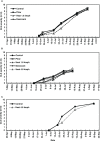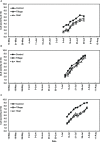An in-field heat treatment to reduce Cercospora beticola survival in plant residue and improve Cercospora leaf spot management in sugarbeet
- PMID: 37229110
- PMCID: PMC10204640
- DOI: 10.3389/fpls.2023.1100595
An in-field heat treatment to reduce Cercospora beticola survival in plant residue and improve Cercospora leaf spot management in sugarbeet
Abstract
Introduction: Sugarbeets account for 55 to 60% of U.S. sugar production. Cercospora leaf spot (CLS), primarily caused by the fungal pathogen Cercospora beticola, is a major foliar disease of sugarbeet. Since leaf tissue is a primary site of pathogen survival between growing seasons, this study evaluated management strategies to reduce this source of inoculum.
Methods: Fall- and spring-applied treatments were evaluated over three years at two study sites. Treatments included standard plowing or tilling immediately post-harvest, as well as the following alternatives to tillage: a propane-fueled heat treatment either in the fall immediately pre-harvest or in the spring prior to planting, and a desiccant (saflufenacil) application seven days pre-harvest. After fall treatments, leaf samples were evaluated to determine C. beticola viability. The following season, inoculum pressure was measured by monitoring CLS severity in a susceptible beet variety planted into the same plots and by counting lesions on highly susceptible sentinel beets placed into the field at weekly intervals (fall treatments only).
Results: No significant reductions in C. beticola survival or CLS were observed following fall-applied desiccant. The fall heat treatment, however, significantly reduced lesion sporulation (2019-20 and 2020-21, P < 0.0001; 2021-22, P < 0.05) and C. beticola isolation (2019-20, P < 0.05) in at-harvest samples. Fall heat treatments also significantly reduced detectable sporulation for up to 70- (2021-22, P < 0.01) or 90-days post-harvest (2020-21, P < 0.05). Reduced numbers of CLS lesions were observed on sentinel beets in heat-treated plots from May 26-June 2 (P < 0.05) and June 2-9 (P < 0.01) in 2019, as well as June 15-22 (P < 0.01) in 2020. Both fall- and spring-applied heat treatments also reduced the area under the disease progress curve for CLS assessed the season after treatments were applied (Michigan 2020 and 2021, P < 0.05; Minnesota 2019, P < 0.05; 2021, P < 0.0001).
Discussion: Overall, heat treatments resulted in CLS reductions at levels comparable to standard tillage, with more consistent reductions across year and location. Based on these results, heat treatment of fresh or overwintered leaf tissue could be used as an integrated tillage-alternative practice to aid in CLS management.
Keywords: Beta vulgaris (sugar beet); Mycosphaerellaceae; integrated disease management; integrated pest management (IPM); leaf residue; propane burner; sugar beet (Beta vulgaris L.); tillage alternative.
Copyright © 2023 Hernandez, Bublitz, Wenzel, Ruth, Bloomingdale, Mettler, Bloomquist, Hanson and Willbur.
Conflict of interest statement
The authors declare that the research was conducted in the absence of any commercial or financial relationships that could be construed as a potential conflict of interest.
Figures




References
-
- Afshar R. K., Nilahyane A., Chen C., He H., Stevens W. B., Iversen W. M. (2019). Impact of conservation tillage and nitrogen on sugarbeet yield and quality. Soil Tillage. Res. 191, 216–223. doi: 10.1016/j.still.2019.03.017 - DOI
-
- Altman J., Campbell C. L. (1977). Effect of herbicides on plant diseases. Annu. Rev. Phytopathol. 15, 361–385. doi: 10.1146/annurev.py.15.090177.002045 - DOI
-
- Battilani P., Beltrami G., Meriggi P., Ponti I., Rossi A., Rossi V., et al. . (1990). Nuovi indrizzi di difesa anticercosporica. Inf. Agrar. 46, 53–70.
-
- Brown W. (1924). II. a method of isolating single strains of fungi by cutting out a hyphal tip. Ann. Bot. 38, 402–404.
-
- Bublitz D. (2019). Innovative methods for detecting and managing cercospora beticola. [dissertation/master’s thesis] (East Lansing (MI: Michigan State University; ).
LinkOut - more resources
Full Text Sources

